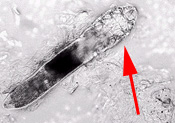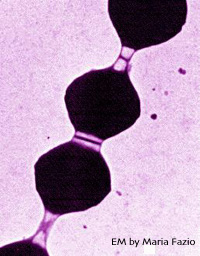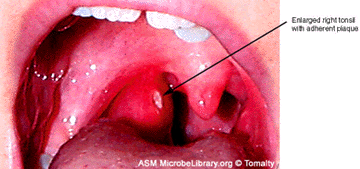What does an organism typically do with its waste products? If you said, "It gets rid of them." you would be right. Waste is waste because it contains mostly materials that are of no use: at least, of no use to the organism that is producing it. But, one species junk is another species necessity. Consider, for a moment, your own skin. Throughout your life, the outer-most cells covering your body are constantly dying and being replaced. Your skin contains a vast number of sebaceous glands and hair follicles, both of which produce oily, nutrient rich compounds. In all three cases, there are energy rich compounds available that are, for most purposes, useless to us. But these materials don't entirely go to waste, because all humans harbor microscopic mites which consume them.
 |
At least two species of mites live commensalistically on the foreheads of humans. Demodex folliculorum lives in hair follicles, whereas Demodex brevis inhabits the sebaceous glands. The mites spend the day in the protected confines of their respective hiding places, but at night they typically will move from one place to another, all the while going unnoticed by their host! To become more familiar with your own commensalistic partners, click here to try this activity. |
|
A Demodex mite |
 |
Bacteria that live commensalistically within our digestive system, when displaced, can cause disease. How many people haven't had strep throat? Strep throat is a disease caused by Streptococcus pyogenes, which lives commensalistically in our own digestive tract. However, when these bacteria find their way into one's throat or onto one's skin, they typically behave as parasites. |
 |
|
| Streptococcus pyogenes |
Good microbe gone bad? Streptococcus pyogenes in the wrong place. |
All scientists are not in agreement on the subject of commensalism, objecting that there is always a cost to a symbiotic relationship. Indeed, studies have linked even our genteel Demodex mites to instances of trouble making. Roseacea and eczema are both conditions that result from our own immune response to a foreign material. Under especially good living conditions (lots of oily wastes), Demodex mite populations have been shown to increase to the point where their collective foraging causes an allergic reaction in their hosts, resulting in rosacea and/or eczema.
The structure of symbioses therefore appear to form a continuum. On one end are associations between organisms that are, in theory, equally beneficial and truly mutualistic and, at the other extreme, there are the parasitic relationships in which one organism benefits while the other is harmed. Right in the middle of this continuum, exists the realm of true commensalism, the existence of which is a subject of much debate.




